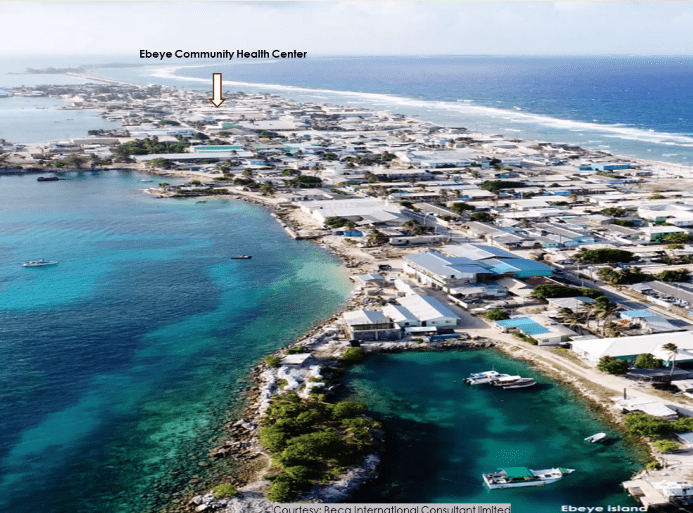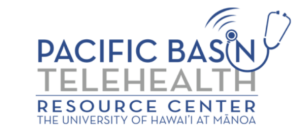Republic of the Marshall Islands Resources
See an overview of telehealth resources available in the Republic of the Marshall Islands
Region Overview
The Republic of the Marshall Islands (RMI) is a chain of over 1,000 volcanic islands, coral atolls, and islets located in the central Pacific Ocean between Hawai’i and the Philippines.
Majuro has a total landmass of 3.75 square miles with a population of 27,797, while Ebeye Island on Kwajelein atoll has 9,614 people on 0.12 square miles.
RMI has been a sovereign nation since 1986 with a Compact of Free Association (COFA) with the United States of America. The total population of RMI as of 2020 was 59,194, with 74% of the population residing on Majuro and Kwajalein atolls.

Health Ecosystem
Healthcare services in the RMI are largely provided by the Ministry of Health and Human Services. Basic public health care is available to all RMI residents with a small copay of approximately $5 for all services. Residents have an option for supplemental insurance. There are private clinics, but the majority of the population uses the public system.
There are two hospitals in RMI, the Leroj Atama Medical Center on Majuro and the Leroj Kitlang Health Center on Ebeye. There are outer island health centers managed under the Four Atoll Healthcare Program – sometimes referred to as the Section 177 Healthcare Program. Bikini, Enewetak, Rongelap, and Utrok are the four atolls in the Republic of the Marshall Islands that were impacted by the nuclear weapons testing program carried out by the US Department of Defense between 1946 and 1958. There are also 56 outer island health centers managed by the hospital in Majuro by the Office of Outer Islands, staffed by local health assistance. Telehealth is in the form of radio communication with Leroj Atama Medical Center in Majuro.
According to the Pacific Island Health Officers Association (PIHOA), RMI has approximately 90-120 off-island referrals annually of which are mostly related to cancer, congenital issues, and orthopedic surgeries.

Health System
Mixed public + private
Health Insurance
National Health Insurance
- Private
- Medicaid for COFA migrants (in US)
Hospitals
Public
- Leroj Atama Medical Center (Majuro)
- Leroj Kitlang Health Center (Ebeye)
Health Centers
- 5 health centers
- 56 clinics
- 1 private
Non-communicable diseases (NCDs) are the most pressing health issue for all USAPIs. In 2010, PIHOA declared a regional state of emergency due to NCDs in the region. The leading NCD contributors to morbidity and mortality are cardiovascular disease, diabetes, and cancer. The Disease Control Priorities 3rd Edition (2015), reports that cancer is now the second most common cause of mortality in most of the USAPI jurisdictions. To further put this in perspective, the incidence of cervical cancer in Micronesia is over eight times higher than the US (79.7 per 100,000 compared to 9.9 per 100,000). The region also has among the highest prevalence of obesity in the world, with some communities reporting as high as 90% prevalence among adults. About 83% of cancers are associated with tobacco use and obesity in the jurisdictions. Behavioral risk factors such as tobacco and alcohol use, lack of physical activity, and unhealthy diets are believed to be the main drivers. These behaviors are modifiable but limitations brought on by geographic isolation, modern lifestyles, and a heavy reliance on imported processed foods make addressing NCDs a unique challenge.
The Marshall Islands joins several other Pacific island nations as having the highest prevalence of diabetes in the world. Similar to other neighboring nations, the diet of the RMI people shifted from traditional staple food such as breadfruit and seafood to imported canned food that are most likely canned in oil and high levels of sodium.
Telehealth Readiness
Regional Leadership Support of Telehealth
The PBTRC Pacific Island telehealth concept paper was submitted and presented to the Pacific Island Health Officers Association (PIHOA) Board of Directors that consists of the Ministers and Directors of Health in the US Affiliated Pacific Islands (USAPI). During PIHOAs 63rd Executive Board Meeting, PIHOA Resolution 2018-63-01 was endorsed which called for unified support for the advancement of telehealth. This resolution prompted the leaders of the Micronesian Island Forum (MIF) to adopt Telehealth Resolution (No. 23-04) during the 23rd Micronesian Island Forum held in CNMI. The Resolution was signed by the Presidents and Governors of the USAPI to build regional and jurisdictional capacity and expansion of telehealth in the region. The PBTRC concept paper was included as an exhibit of the Telehealth Resolution (No. 23-04).
Broadband Infrastructure
The Republic of the Marshall Islands achieved high speed internet through its connection with the HANTRU-1, a fiber optic cable connection between the Reagan Test Site in Kwajalein Atoll (in the Marshall Islands) to Guam in 2010. Despite the high speed fiber optic connection, the healthcare sector in the Marshall Islands has yet to benefit from it.
Some of the challenges and barriers noted in an assessment of e-health resources and readiness in a study (titled: An Assessment of E-health Resources and Readiness in the Republic of the Marshall Islands: Implications for Non-communicable Disease Intervention Development) published in the Hawaiʻi Journal of Health & Social Welfare include: issues with connectivity at home due to high cost, and lack of technical support for maintaining required technology for e-health programs. In August of 2021, the World Bank approved a $30M project to improve internet connections in the RMI. This project is aimed at improving the internet connection and providing more reliable and affordable access to the country. This project includes improvements in digital government platforms that include initiatives to support e-health (health care sector).
Current and Emerging Telehealth Initiatives
- Referral Management: The Leroj Kitlang Health Center on Ebeye uses video teleconferencing to communicate with Leroj Atama Medical Center on Majuro for patient referral management and continuity of care.
- Shriners Children Hospital: Telehealth services are utilized by Shriners Children Hospital to evaluate new patients and provide consulting for post-surgical examinations and follow-ups.
Continued Medical Education Courses
Pacific Open Learning Health Net (POLHN)
Courses offered by POLHN are available to all eligible staff. The following are programs offered through the POLHN:
- Pacific Paramedical Training Centre (PPTC) in New Zealand: Provides training in the medical laboratory sciences.
- The Penn Foster Dental School (PFDS): American based college in association with the Pacific Basic Dental Association. PFDS offers a nine month Dental Assistant Career diploma with this partnership.
- POLHN partners with the Fiji National University (FNU) to offer online courses through the School of Public Health. There are a number of courses that are offered including: postgraduate certificate or diploma in Applied Epidemiology, Postgraduate certificate or diploma in Health Research, Postgraduate certificate or diploma in Health Service Management, Masters in Health Service Management, Postgraduate certificate or diploma in Public Health and a Masters in Public Health.
- University of Fiji: Registered nurses at the MOH can apply for the Bachelor of Nursing, Master of Nursing (thesis) and Master of Nursing (coursework).
Project ECHO
Program provides primary care physicians specialty knowledge and training through distance learning in order to provide quality services to their patients in rural areas. The specific programs include: Endocrinology/Diabetes, Geriatrics, Behavioral/Mental health.
Informal Physician Exchange
Similar to other island jurisdictions, the physicians in the Federated States of Micronesia have been able to utilize email, Skype, FaceTime, texting, and messenger applications to communicate with other physicians and/or specialists in an informal type of physician exchange solution. Through the creative utilization of these applications, Physicians are able to consult with their peers to provide recommendations. Although in the FSM, HIPAA compliance is not enforced, if services and/or communication takes place with a provider in the United States, the US federal regulations apply.
